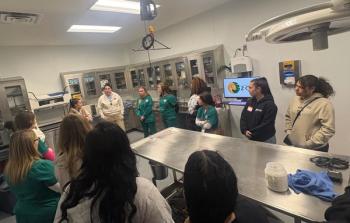
Veterinary professionals: Dont skip the diff
Performing a manual differential on every CBC you do sounds like a drag, but it could make all the difference for your veterinary patients.
With the advancement of very sophisticated complete blood count (CBC) automatic analyzers, many of us in the field have forsaken the “good ol' diffing.” So, should we still do manual differentials on our CBCs?
The answer is an unequivocal “yes.” And here is the why, how and when.
Why should we diff? Because, it may not be raining after all …
You're getting ready for a night out, putting on your best clothes. Your iPhone weather app says it's raining. What do you do? Do you just don your rain boots, rain coat, umbrella and head out?
No. You first look through your window to see for yourself! This is why you should also always perform a manual differential, or a “diff,” on every CBC you do. To see for yourself. Yes, just like your iPhone, today's analyzers are very sophisticated and very capable. They can differentiate among many species and give you excellent results. However, they cannot replace your eyes.
How should you diff? Let's dig in
Assuming we are all familiar with the basics of a CBC analysis, let's start with platelets. Platelets can be especially confusing to the automated analyzers, with cat platelets more so than dogs'. A machine cannot always account for platelet clumps and may count a clump of many platelets as just one single platelet. Also, it may confuse very large, reactive platelets for red blood cells. If this happens, you may get a machine result with low platelets (thrombocytopenia). You now need to evaluate a blood smear to confirm if this low platelet count is “real.” One routine way to perform a platelet estimate is to count 10 fields (on 100x oil) and get the average per field and then multiply that number by 15 and 20, and that will give a platelet range estimate. For example, if your average was 10.2 plt/field, then your platelet estimate range is 153-204K/uL.
Platelet clumps on 10x. (All images courtesy of Djana Padbury-Zivkovic.)
Feline macroplatelet (100x oil)
Red blood cells (RBCs) can have a multitude of morphological features that may not be “picked up” by an analyzer, some of them more clinically significant than others: Echinocytes Type III, to confirm a snake envenomation (“wet bite”); Spherocytes, to confirm IMHA; Heinz Bodies, to confirm some kind of oxidative damage process to RBCs. These are just some of them. Look for RBCs on 50x or 100x oil. While you will want to stay in the monolayer to evaluate for most of these, when it comes to spherocytes, you should head toward the intersection of monolayer and the body of the smear, as RBCs tend to flatten and lose central pallor in the monolayer and may be tricky to assess for true spherocytes.
Note the sharp, thin, symmetrical spikes in these Echinocytes Type III (100x oil)
You've probably heard that you should stay away from the body of the smear and focus mostly on the monolayer. However, there is one thing you should be looking for in the body: RBC agglutinants. These will be easily spotted even on 10x, deep in the body of the smear. If your patient is anemic, and you are seeing these RBC clusters (to be distinguished from rouleaux), this is an indication to perform a saline agglutination test for confirmation.
RBC agglutination (10x)
Feathered edge is another place where we are usually taught not to spend that much time. However, this is where a lot of large and heavy things like to end up: platelet clumps, lymphoblasts, mast cells or heartworm microfilaria. Feathered edge is not a place to be ignored. Oftentimes, a quick glance on 10x will be sufficient to spot some of the above-mentioned items.
HW microfilaria feathered edge (10x)
Mast Cells (10x and zoomed in 50x oil)
Abnormal lymphocytosis Feathered edge (10x)
When it comes to white blood cells (WBCs), your eye will be much better than a machine at catching lymphoblasts, toxic neutrophils, bands and nucleated RBCs. Nucleated red blood cells (nRBCs) are often confused for lymphocytes by a machine, and therefore a careful WBC differential including nRBCs should be performed. If you see more than 5nRBC/100WBC, make sure to do the corrected WBC count: (RBC x 100) : (100 + nRBC) = corrected WBC/uL.
A manual smear evaluation can also assess for different inclusions (Mycoplasma in cats, Babesia in dogs, to mention just a couple of them), as well as rare instances of bacteria.
Intracellular bacteria (100x oil)
Intracellular bacteria (100x oil)
When should you do a diff? EVERY TIME.
Most patients that come through your practice will likely have normal CBCs, and you may tend to want to skip the diff. But these are important to do for two reasons: to confirm the machine results, and also to teach yourself what is normal, so that you can easily recognize abnormalities when they occur.
Initially, it might take you 10 to 15 minutes to perform a single complete diff, but as you keep doing them, you will see your diffing time drop into single digits. You will also feel a huge sense of accomplishment every time your differential helps a doctor's diagnosis and treatment. And you may eventually learn to like “diffing.”
Djana Padbury-Zivkovic, CVT, is a technician at Wheat Ridge Animal Hospital in Wheat Ridge, Colorado.
Newsletter
From exam room tips to practice management insights, get trusted veterinary news delivered straight to your inbox—subscribe to dvm360.






